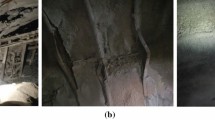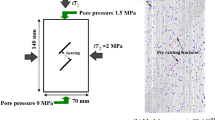Abstract
In the each loading stage, strain and creep strain occurs instantaneously on the axial and lateral of fractured. Instantaneous strain leads to the 80% overall specimen deformation. The axial strain is about 2–3 times larger than the lateral strain. Instantaneous strain completed time and deformations under each loading stage decrease when the loading time increases. With the increasing of loading, axial strain and lateral strain of fractured phyllite present the approximate linear curve growth change. With increasing of axial stress, the relationship between the lateral strain and axial strain transform from the linear increased trend to the index increased trend. With the increasing of moisture content, the axial deformation and lateral deformation of fractured phyllite increase. The curves of axial strain and lateral strain under soaked for 10 and 15 days condition are similar. The modified Burgers model can describe each creep stage of fractured phyllite which have high fitting precision, less fluctuation and high reliability. Therefore, modified Burgers model can provide an effective way to analyze the creep characteristics of fractured phyllite.










Similar content being viewed by others
References
Andrade ENC (1910) On the viscous flow in metals, and allied phenomena. Proc R Soc Lond. Ser A, Contain Pap Math Phys Charac 1–12
Bråtveit K, Bruland A, Brevik O (2016) Rock falls in selected Norwegian hydropower tunnels subjected to hydropeaking. Tunn Undergr Space Technol 52:202–207
Brignoli M, Sartori L (1993) Incremental constitutive relations for the study of rock creep. Int J Rock Mech Min Sci 21(7):1319–1322
Griggs DT (1939) Creep of rocks. J Geol 47:225–251
Günther RM, Salzer K, Popp T et al (2015) Steady-state creep of rock salt: improved approaches for lab determination and modelling. Rock Mech Rock Eng 48(6):2603–2613
Haeberli W (2000) Modern research perspectives relating to permafrost creep and rock glaciers: a discussion. Permafrost Periglac Process 11(4):290–293
Hu K, Feng Q, Wang X (2017) Experimental research on mechanical property of phyllite tunnel surrounding rock under different moisture state. Geotech Geol Eng 35(1):303–311
Kilian R, Heilbronner R, Stünitz H (2011) Quartz grain size reduction in a granitoid rock and the transition from dislocation to diffusion creep. J Struct Geol 33(8):1265–1284
Kwon SH, Kim YY, Kim JK (2004) Analysis on creep of concrete under multiaxial stresses using microplane model. J Korea Concr Inst 16(2):195–204
Lu Z, Yao HL, Liu J et al (2015) Study on the rheological properties of the surrounding rock of a deep buried phyllite tunnel. In: 49th US rock mechanics/geomechanics symposium. American Rock Mechanics Association
Moghadam SN, Mirzabozorg H, Noorzad A (2013) Modeling time-dependent behavior of gas caverns in rock salt considering creep, dilatancy and failure. Tunn Undergr Space Technol 33:171–185
Nilsen B (2014) Characteristics of water ingress in Norwegian subsea tunnels. Rock Mech Rock Eng 47(3):933–945
Shang Y, Yue Z, Park HD et al (2015) Brittle fracture and plastic creep of the completely decomposed granite presented in CT. Geosyst Eng 18(6):338–347
Yuan H, Cao P, Xu W et al (2006) Visco-elastop-lastic constitutive relationship of rock and modified Burgers creep model. Chin J Geotech Eng 28(6):796–799
Zaman MM, Abdulraheem A, Roegiers JC (1995) Reservior compaction and surface subsidence in the North Sea area. J Geol 5:373–379
Author information
Authors and Affiliations
Corresponding author
Rights and permissions
About this article
Cite this article
Hu, K., Feng, Q., Li, H. et al. Study on Creep Characteristics and Constitutive Model for Thalam Rock Mass with Fracture in Tunnel. Geotech Geol Eng 36, 827–834 (2018). https://doi.org/10.1007/s10706-017-0357-y
Received:
Accepted:
Published:
Issue Date:
DOI: https://doi.org/10.1007/s10706-017-0357-y




